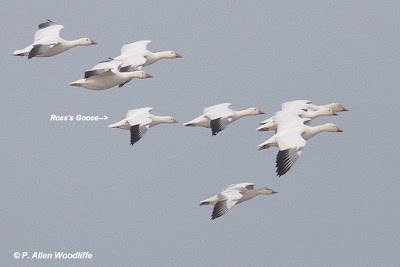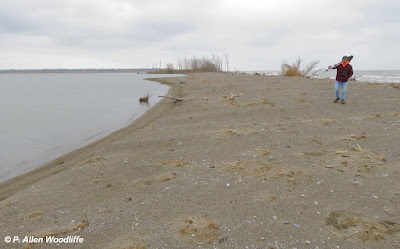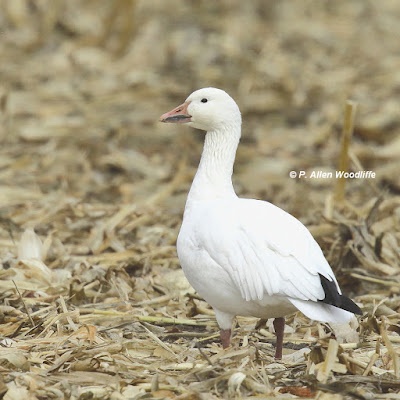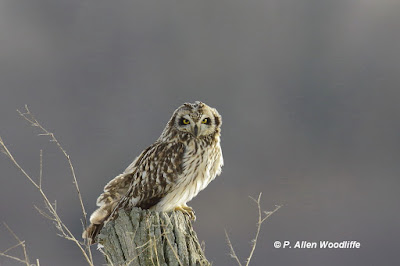The year 2020 is just about out the door. Here is hoping that 2021 is much better on a whole bunch of fronts! Meanwhile, getting out and finding birds is still one of the most satisfying, and safest things to do right now, so that is what I've been doing as much as possible.
The Erieau Rail Trail can be good, when the wind isn't blowing too hard since it is quite exposed. Those days are sometimes rare. But a visit not too long ago, just after a bit of snow, gave me a few things to look through. One of the target species was Common Redpoll, which don't always come through this part of the province in good numbers, but this year it has been much better than normal. I was also looking for the rarer Hoary Redpoll, but although one or two others had seen one here, I did not. The flock of redpolls was flighty, so I only got a good look at a few of the ~45 birds that were in the area.
....as were a few Song Sparrows, one of which was partially in view for a short time.
I also got out to roam around the area northwest of Chatham, looking for Snowy Owls. With a bird count in this area coming up shortly, it is always useful to find out where they are hanging out. I found 5, but most were well out in a field and not worth trying to photograph from the road. I did see a woman well out in the field as well, trying to get close enough to get a decent photo with what appeared to be a fairly basic camera requiring her to be up close. The owl was having none of it, however, and kept moving off. I had better luck, as I found a Snowy inside a chain link fenced area, and I was able to get this shot from my vehicle. The owl seemed quite unconcerned.
I also wanted to check on the ongoing reports of Snow Geese and a Ross's Goose at the Ridgetown Sewage Lagoons. I had seen them there a few weeks ago, but am always on the lookout for more and better photos. At first the Snow Geese were on a berm quite unsuitable for good photos. But waiting a bit was the key, as after a few minutes this group got up to go to a field of corn stubble nearby. This photo shows a 'blue' phase, in the upper left, as well as a first year bird, the lowest one on the right. The rest were mostly typical white Snow Geese....
...but not all of them. The Ross's Goose was in this group. It is relatively easily separated from a Snow due to its smaller size, a shorter, stubbier bill with no grin patch, and a slightly rounder head. If you click on the photo, these characteristics may be more apparent.
But the biggest event of the last few days has been the Wallaceburg/Walpole Christmas Bird Count, held on Dec 27. I helped get this count going back in 1986. My territory for most of the last couple of decades has included the St. Clair River north of Walpole Island as well as several roads and more woodland areas inland from the river, so there is a nice diversity of habitat. But the most important part is the river.
Unfortunately the river did not have a lot of waterfowl this year, compared to many years. It seems there hasn't been enough cold weather, forcing birds down from the more northern lakes. There was no ice on the river at all, and not many gulls either. Nonetheless there were enough to make parts of it interesting, but photographing the waterfowl had its limitations. Here are a few of the things I saw.
There were a fair number of Bufflehead, shown first. This one was getting ready for flight, and I got this shot a split second before it lifted off, hence its wing is partially out.
There were a few Greater Scaup....
....and even fewer Lesser Scaup. The photo below actually shows a female Greater on the left, and a Lesser in the center. It is slightly smaller, has a slightly more peaked head, not as rounded, and the dark tip of the bill is much more restricted compared to a Greater.
There were a few gulls, and by far the most common was Herring Gull. I saw a couple of Ring-billed and Greater Black-backed Gulls but they were way too far off, mostly on the other side of the river.
A highlight was seeing a group of seven Hooded Mergansers but from a distance in a wide creek. The best photo opportunity for this species came at about the end of the day, as this male Hoodie was resting on a piece of ice in a narrow creek along a quiet road. I was able to get almost full frame shots of it right from the vehicle.
Mallard.....yes, there are always some Mallards around, so when the photos of more exciting things are hard to come by, why not shoot a Mallard....
...or one of the numerous exotic Mute Swans?
Certainly a little more exciting were 21 Tundra Swans right close to the river shore downstream from Sombra. They are more often seen in fields well away from the river.
As mentioned, I did some more inland areas, where songbirds and non-waterbirds were to be found. I found a fair number of American Tree Sparrows in a couple of locations.
A few Downy Woodpeckers came in to check me out as I 'pished' for birds.
Mourning Doves aren't exactly uncommon, but when a photo op presents itself, I'll take it!
Rock Pigeons were fairly plentiful, although most of them were across the river, roosting on a building connected to a power plant. But there were a few resting on some hydro wires along the road, and with a nice sky background for a change, why not?
Certainly the highlight of the inland birds was this Short-eared Owl. Okay it isn't all that obvious, and I wouldn't have seen it if I hadn't met Mike B along the roadside who had seen it fly in and land way out in the field. I took a couple of photos of it in mid-morning, but there was just enough sunlight to create some haze, and those photos were not worth keeping. I came by again later in the afternoon when the sun was behind some clouds, and there was no problematic sunlight haze. Unfortunately the owl was always facing the opposite direction, so this is the best I could do. Between the camera/lens combination and some severe cropping, this photo is at about the equivalent of about 140 X!
The count ended up with 85 species plus an unidentified shorebird, which was a bit higher than normal.
This is likely the last post before the new year, as I will be busy preparing for the next bird count on January 1, so with that I will wish all readers a Happy New Year!


















































